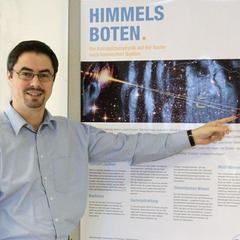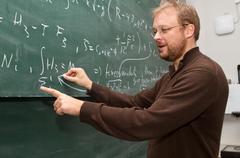URL: https://www.desy.de/news/news_search/index_eng.html
Breadcrumb Navigation
DESY News: EU provides millions to fund research into neutrinos and cosmic inflation
News
News from the DESY research centre
EU provides millions to fund research into neutrinos and cosmic inflation
The European Research Council (ERC) is funding two research projects by scientists working at DESY through so-called ERC Consolidator Grants. Walter Winter, who works in Zeuthen, will receive some 1.75 million euros over a period of five years for his project “NeuCos – Neutrinos and the origin of the cosmic rays”, while Alexander Westphal, based in Hamburg, will receive 1.85 million euros over the same period for his research into “Inflation in String Theory – Connecting quantum gravity with observations”. The generously endowed ERC Consolidator Grant is awarded to outstanding, highly-talented scientists as part of the EU funding programme “Horizon 2020”, to support their independent and self-reliant research activities.

Walter Winter is receiving the ERC grant for his project NeuCos.
In his project, Walter Winter, who also teaches at the Humboldt University in Berlin, is intending to examine cosmic radiation more closely. Although this form of radiation was discovered more than 100 years ago, its origins still pose a number of questions. The sources must have been gigantic particle accelerators, however their precise nature remains unknown, especially for the highest energies. Potential candidates as the accelerators of these cosmic particles include gamma ray pulses and active galactic nuclei.
Another puzzle posed by cosmic radiation is its chemical composition: data from the Auger experiment points to heavier atomic nuclei at extremely high energies – a result that raises new questions. At the same time, observations carried out on extremely energetic neutrinos in 2013 using the neutrino telescope IceCube have revolutionised high-energy astrophysics. For the first time, a further piece in the puzzle of the nature of cosmic accelerators had been found, in addition to photons and cosmic radiation.
One of the aims of the research project “Neutrinos and the origin of the cosmic rays” is to develop a common basis for these different observations. To achieve this, Winter wants to set up an interdisciplinary theoretical working group involving experts from the field of astrophysics and particle physics. The team will develop theoretical models of the sources of heavy nuclei, so as to obtain new evidence for the origins of cosmic radiation from the observational data on the different cosmic messengers. Another goal is to study the properties of neutrons with the help of future neutrino telescopes.

Alexander Westphal will receive 1.85 million for his project Stringflation.
High-precision measurements of the cosmic microwave background (CMB) in a number of experiments, e.g. the WMAP satellite and later the European Planck satellite, or BICEP2 and the Keck Array (both in the Antarctic), are now for the first time giving researchers the scientific foundations for studying the inflationary phase at the very beginning of time. One of the characteristic signals of the inflationary epoch is the production of gravitational waves, which can in principle be detected in the CMB via specific polarisation patterns in the microwave radiation, which might soon be observed in the experiments.
Alexander Westphal’s Stringflation project will examine how inflationary models can be incorporated into string theory. String theory is one of the candidates for a unified description of the laws of physics, including the theory of quantum gravity. In string theory, the fundamental building blocks of the universe are considered to be tiny, vibrating strings. Depending on the type of vibration, these strings can be manifest as one type of particle or another. The problem is that these strings are so small as to be beyond the reach of any experiments that can be conducted using present-day technology. The theory has an abundance of solutions describing various different possible universes, each displaying different physical laws, which can be confirmed under experimental conditions that are accessible to us. This means that an entire range of possible inflation models exists in string theory.
Westphal wants to filter the existing inflation models that can be described using string theory according to the frequency with which they produce inflationary gravitational waves of observable magnitude. Using these gravitational waves as visible consequences, Westphal is hoping to come up with the first approach capable of testing string theory experimentally.



